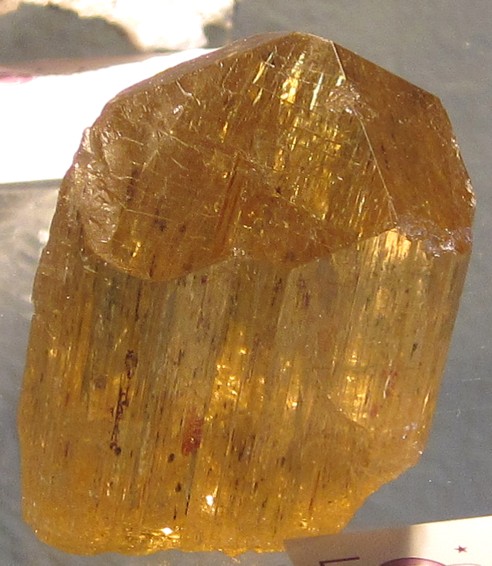|
.
Scapolite Mineral Facts:
Chemical Formula: Ca4(Si,
Al)12O24(CO3,SO4) in
isomorphic mixture with Na4(Al, Si)12O24Cl
A group of minerals varying in
composition by the isomorphous
mixture in different amounts of the two molecules above, together with
small amounts of chlorine, carbonate and sulfate. Calcium end member
designated Meionite, Sodium end member Marialite.
Colors:
colorless, yellow, grey or greenish;
Scapolites are occasionally nearly black from
the presence of very small enclosures of
graphite material. Colorless when free from iron
and other impurities.
Hardness:
5 to 6
Density: 2.5
to 2.8
Cleavage:
Massive form, no
cleavage observable.
Crystallography: Tetragonal
The habit of the crystals is always
prismatic and columnar. Crystals are
usually coarse, with rough faces and often large.
The scapolites occur also in crystal grains
embedded in limestones, in columnar and fibrous aggregates and in
structureless masses.
Luster:.
Vitreous
glassy luster, which at times
approaches pearly.
Can be transparent to opaque.
Optics:
(Refractive Index):
= 1.55
For the two end members of the group the
indices for yellow
light are: marialite, a= 1.5463, b=1.5395, meionite, a=1.5897,
b=1.5564.
|

Scapolite Crystal Specimen |
|
Composition,
Structure and Associated Minerals:
The scapolites are a group of
rock-forming tectosilicate minerals composed of aluminium, calcium, and
sodium. The scapolite minerals
occur in the crystalline schists, gneisses, amphibolites and greenschist,
and in many cases have probably been derived by alteration from plagioclase
feldspars. They also characteristically occur in
crystalline limestones and also in limestones included
in volcanic lavas (meionite), and on the contacts of igneous masses (wernerite).
They are found also in igneous rocks as the result of alteration of the
feldspars, especially when these rocks are intrusive in limestones, and also
as an alteration product of garnets. In a few places they are associated
with magnetite
and apatite in veins of iron ores. In most cases they appear to have
been derived from feldspars by the action of metamorphic processes..
Associated with light colored pyroxene, amphibole,
garnet,
apatite,
sphene,
zircon,
albite, muscovite and to a mixture of minerals.
The scapolite minerals are easily altered through weathering into various
other minerals, such as mica,
epidote, talc, kaolin, etc.
Identification and Diagnostics
Before the blowpipe all members swell
and fuse to a white glass. In hydrochloric acid, mixtures between Ma and
Ma2Me are insoluble, those between Ma2Me and MaMe2 are partially soluble
with imperfect decomposition
and those between MaMe2 and Me are nearly
completely soluble, yielding separated
silica but without the formation of a jelly.
All members of the series are distinguished by their
crystallization and cleavage and all except pure meionite are characterized
by the chlorine reaction. They are distinguished readily from the feldspars
by their fusibility with swelling.
Varieties containing sodium give yellow flame on ignition.
Occurrence,
Localities and Origins:
Wernerite, or common scapolite shows
a combination of the two molecules according to the ratios of Me : Ma as 3 :
1 to 1 : 2; while mizzonite corresponds to the ratios of Me : Ma as 1 : 2 to
1 : 3. Mixtures in all proportions may exist. The other members of the
group, meionite, mizzonite and marialite, are much rarer in occurrence.
Their crystals are usually smaller and of better quality than those of
wernerite. Meionite and missonite are found in limestone blocks on Monte
Somma (Vesuvius) in Italy. Pure marialite
and meionite are rare. The common scapolites are the mizzonites of which
dipyr and wernerite are the nontransparent varieties. The former includes
varieties occurring in elongated prisms.
Scapolite is found in various places in
Massachusetts; Orange, Essex, Lewis, Jefferson and St. Lawrence counties,
New York; at Grenville, Templeton, Algona, etc., Canada.
Meionite crystals occur in the fragments enclosed in
the lavas of the Lake Laach region, Prussia; and of Monte Somma, the
precursor of Vesuvius, Italy. Mizzonite is associated with meionite at Monte
Somma. Dipyr occurs in clayey limestones in the Pyrennees; wernerite at
Arendal and Bamle, Norway; at Malsjo, in Sweden; at Diana, Lewis Co., and at
Gouverneur and Pierrepont,
St. Lawrence Co., N. Y.; at Canaan, Conn.; at Bolton, Mass.; and marialite
at Ripon, Quebec, and at Pianura, near Naples, Italy. The fine marialite
crystals pictured with this web page are from Tanzania.
Return to the
Mineral Collectors Information Page
|

Purple Scapolite close up |
|



